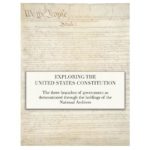In 1966, the Supreme Court’s 5-4 ruling in Miranda v. Arizona dramatically changed criminal procedures. The Court linked the Fifth Amendment’s privilege against self-incrimination to the Sixth Amendment’s guarantee of a right to counsel and applied both to protect a suspect’s rights from arrest through trial. This lesson plan is based on the Annenberg Classroom video “The Right to Remain Silent: Miranda v. Arizona.”
Gideon v. Wainwright (1963) Middle School Level

Does the Sixth Amendment’s right to counsel in criminal cases extend to defendants in state courts, even in cases in which the death penalty is not at issue? High school level also available.
This case summary provides teachers with everything they need to teach about Gideon v. Wainwright (1963). It contains background information in the form of summaries and important vocabulary at three different reading levels, as well a review of relevant legal concepts, diagram of how the case moved through the court system, and summary of the decision. This resource also includes nine classroom-ready activities that teach about the case using interactive methods.
Alabama v. Shelton (2002)
Does the Sixth Amendment right to appointed counsel apply to a defendant who was sentenced to a suspended sentence? This case summary shows how the Supreme Court answered that question in 2002.
Miranda v. Arizona (1966)

This case summary provides teachers with everything they need to teach about Miranda v. Arizona (1966). It contains background information in the form of summaries and important vocabulary at three different reading levels, as well a review of relevant legal concepts, diagram of how the case moved through the court system, and summary of the decision. This resource also includes ten classroom-ready activities that teach about the case using interactive methods.
Key Constitutional Concepts

This three-part documentary discusses why and how the Constitution was created at the Constitutional Convention and explores the protection of individuals’ rights in the Supreme Court case Gideon v. Wainwright and limits on presidential power through checks and balances in the Supreme Court case Youngstown v. Sawyer.
Each segment is about 20 minutes.
Closed captions available in multiple languages, including Spanish.
Exploring the United States Constitution eBook

Each chapter connects one or more of the billions of primary source documents in the holdings of the National Archives to the principles found in the United States Constitution. These documents exemplify the workings of the three branches of the federal government as laid out in our Constitution. This eBook is available as a Multi-Touch book for iPad and Mac on iTunes, or for PC, Android devices, Mac, iPhone, iPad, or eReader with Scribd.
To Kill A Mockingbird and the Scottsboro Boys Trial: Profiles in Courage
Constitutional Index – Amendment 6 Assistance of Counsel Clause
The Constitutional Index breaks down the U.S. Constitution by Section, Amendment, and Clause and contains broader topics and themes. These are used to cross-reference Library resources in an effort to annotate constitutional history.
Right to Counsel
In this lesson, students will look at the various dimensions of right to counsel. They will study how the meaning of this right has evolved over time with reference to specific landmark United States Supreme Court cases. Students will develop lists of reasons why such a right is important to the functioning of the adversary process. The lesson ends with an examination of the role of the criminal attorney.
